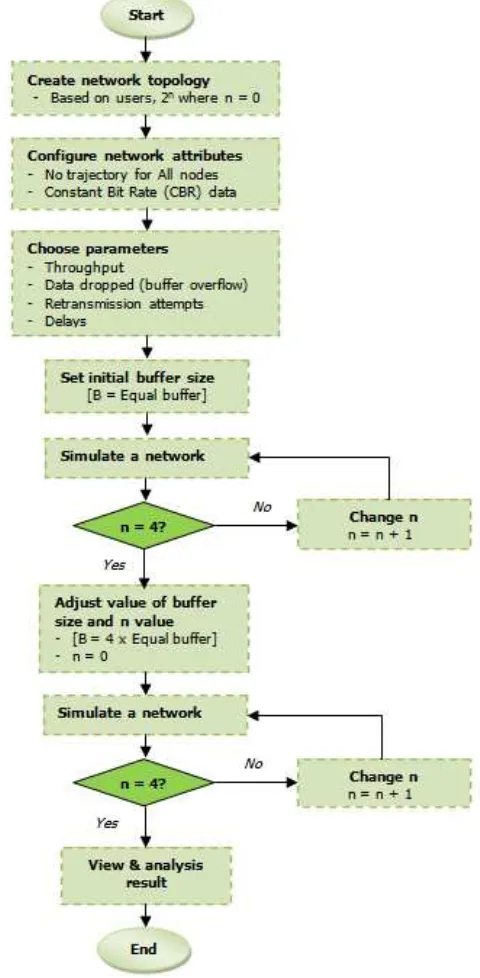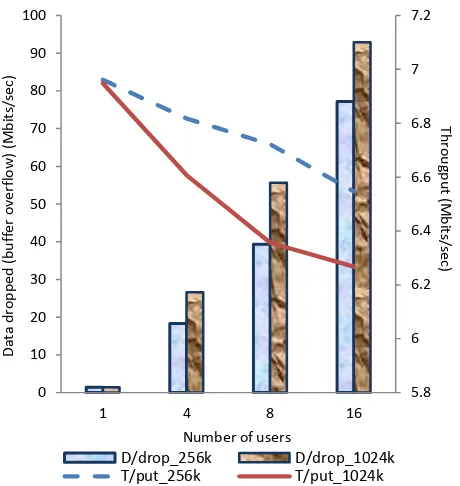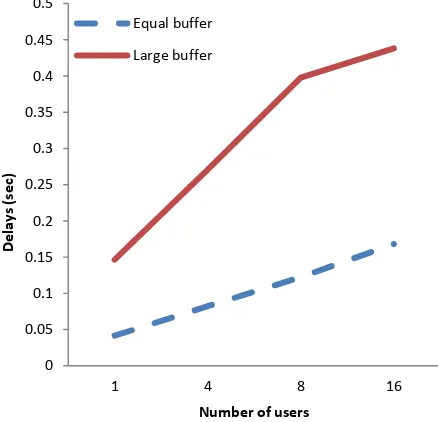ISSN: 2221-0741
Vol. 1, No. 6, 269-273, 2011
Congestive Loss in Wireless Ad hoc Network
Network Performance Analysis
Haniza N., Zulkiflee M., Abdul S.Shibghatullah, Shahrin S.
Faculty of Information and Communication Technology, Universiti Teknikal Malaysia Melaka, Melaka, Malaysia Email:{haniza,zulkiflee;samad;shahrinsahib}@utem.edu.my
Abstract -Communication in wireless network is quite susceptible to mobility, nodes capacity and power consumption level. These might contributes to the major problem of TCP performance degradation where there are highly potential of packet loss and packet reordering. In this research, we manage to observe the impact of packet behavior once the node’s capacity is limited when passing on-going data. This condition occurs when the node’s buffer starts to be overloaded. A simulation study by using OPNET Modeler 14.5 is conducted to achieve the purpose. A static ad hoc topology with the size of users (2n where n=0,
1, 2, 3 and 4
) is used to observe several parameters such as throughput, number of packet dropped, retransmission count and end-to-end TCP delay. The results show that the size of buffer for ad hoc node influence the network performance whenever number of users is changed. In future, we plan to extend this study in a way of deeply understanding the effect of mobility in wireless network.
Keywords – Wireless; Ad hoc; CBR; BER; OPNET; network congestion; buffer size; PLI.
I. INTRODUCTION
Wireless is an alternative advanced technology that plays an important role to convey shared information among users wherever there is limited by distance and cost. This can be seen its current applications in WLAN, Satellite Network, Wireless Sensor Network and Cellular Network. It shows that a big step has been took places in a modern communication nowadays. However, the communication over wireless environment still faces its own challenges [1, 2] such as:
High Bit Error Rate (BER) Mobility
Power / Energy consumption Channel Contention
Topology Changes
For an ideal case, each packet should be arrived at destination and then ACKs will be sent to inform it has been successfully received and awaiting for next packet delivery. However, there are potential of unexpected events happened during packet delivery as discussed in [3]. For wireless, these challenges contribute to two main problems [4, 5]: packet loss and packet re-ordering. Both problems give a sign of network congestion phenomenon. In order to verify these problems have been occurred, the majority of researcher makes a simple measurement by observing the value of throughput [6].
As a solution, the Congestion Control mechanism [7] has been adapted to the de facto standard, TCP. Almost 90 % of Internet traffic comes from TCP-based [8, 9] and there are many TCP variants has been developed over 20 years. To deal with heterogeneous network, this mechanism had experienced some modification. Unlike
wired, the inability to interpret the types of packet loss in wireless [10, 11] which normally represents congestion situation drives into wrong congestion control action later. Hence, the wireless network performance shows a drastically degradation.
In this study, the paper goal is to study the packet behavior in wireless network. This will be demonstrated on a small group of users which the size of users is given as a formula, 2n where n=0, 1, 2, 3 and 4. A simulation study is carried out with OPNET Modeler 14.5 [12].
The rest of the paper is organized as follows. Section II reviews the wireless architecture, types of packet loss and current approach to deal with packet loss in wireless. Section III describes an experimental study about packet behavior in wireless network. In Section IV, we analyses the simulation results. Section V concludes the present paper and discusses some possible extensions of our work.
II. BACKGROUND STUDY
A. Wireless Infrastructure
Basically, there are two types of Wireless Infrastructure: Ad hoc mode and Infrastructure mode. The former form allows nodes to be connected without Access Point. Each nodes act as a router and forward packet until arrived at the destination. MANET and Vehicular Ad hoc are examples for ad hoc wireless network.
B. Congestive Loss vs. Non-Congestive Loss
Like wired, the network congestion also happened in wireless network. However, the causes of this problem have been contributed mainly from the wireless properties itself. It is related to link properties, channel properties and mobility rather than limited resources capability as in wired. Therefore, the assumption of packet loss as the only indication of the present of congestion problem is not suitable for wireless anymore. In many studies, researcher has defined two types of packet losses based on their causes: Congestive Loss and Non-Congestive Loss.
Congestive loss [4] refers to packet loss mainly caused by limited buffer space availability. Once it has been detected, then the traditional TCP Congestion Control will start to do control and recovery activity. This activity involves retransmit the lost packet only (Fast Retransmit) and remain the level of packet transmission without re-enter Slow Start phase (Fast Recovery). The well-known TCP Congestion Control is called TCP Reno [13].
Meanwhile, Non-Congestive Loss [14] is refers to packet loss caused by link, channel and mobility. Since wireless is error-prone environment [15], therefore the practical action towards packet loss is retransmitting the lost packet only. There is no congestion control applied when this non-congestive loss has been detected. This decision is important to avoid from drastically wireless network performance degradation if both losses considered as equal.
C. Wireless Congestion Control
The initial Congestion Control mechanism was invented for TCP traffics in wired environment. When wireless start deployed widely in communication world, this mechanism has been adjusted to handle congestion problem which also occurred in wireless. The weakness of TCP Congestion Control obviously appeared when the TCP Reno fails to react effectively in wireless [16]. To overcome this weakness, the congestion avoidance phase has been enhanced by identifying the potential types of packet losses before deciding the possible action to be taken. This approach is called as Packet Loss Identification (PLI) [6, 17].
Implementation of PLI can be categorized into three types [18] which are Single Metric-based, Multiple Metric-based and Inference-based. Common metrics [19] used such as round trip time (RTT), inter-arrival time, jitter, congestion window , average loss ratio and others. In some cases, a small packet has been created as additional information during data transmission. To have more accurate identification, the information from router likes Explicit Congestion Notification (ECN) [20] and Backward Congestion Notification (BCN) [21] also used.
The implementation of PLI can be seen in many wireless congestion control solution such as TCP Westwood [22], TCP Jersey [1], NCLPD [23], TCP Vegas [24], TCP WELCOME [25], TCP Peach [26], TCoWN [27], TCP Veno [28], JTCP [29], TCP CERL [30] and others.
III. METHODOLOGY
In this study, a proper methodology has been designed to get an expected output. This can be referred to the following work flow depicts in Figure 1.
Figure 1 : Methodology to be used
There are two scenarios created to represent Scenario
In this section, a simple ad hoc network was designed as illustrated in Figure 2. This network consists of a group of mobile wireless users are located surrounding to a fixed wireless node as a ring topology. For all mobile nodes, they are considered as stationary nodes (no trajectory) and expected to work perfectly where all in-range of wireless coverage. The detail information of wireless network as stated in Table 1 below.
Figure 2 : The proposed network
TABLE 1:WIRELESS NETWORK CONFIGURATION
WLAN Technology IEEE 802.11b
Physical Characteristic
Direct Sequence Spread Spectrum (DSSS)
Data rate (bps) 11 Mbps
Transmit Power (W) 0.001
Packet
Reception-Power Threshold
-67
For application configuration, the streaming application with a high video resolution was chosen. The surrounding nodes are expected to access this application from a fixed node where its buffer size will be adjusted later on.
B. Evaluation Metrics
In this study, the capability of buffer at a fixed node was observed. Packets are expected to be dropped if buffer space is overloaded. This action is known as Drop
tail which is the most widely deployed scheme today. We collect some useful information such as throughput, number of packet dropped, retransmission count and end-to-end TCP delay. This selection based on possible output to represent a possible scenario once network begin to be congested.
V. SIMULATION RESULTS & ANALYSIS In this section, the simulation result for the impact of the changing of buffer space at a fixed node was presented. We use two values of buffer sizes which are B = 256kbits, referred as the “equal buffer” and another is given as B = 1024kbits, referred as the “large buffer”. These values have been selected to show the differences of buffer space availability for ad hoc topology towards network congestion.
Figure 3 : The relationship between data dropped and throughput
respected to number of users, 2n
throughput for both buffer cases. However, this trend start to decrease once number of users changed. For large buffer case, it shows that its throughput is much lower than an opposite case. As expected, the throughput should be decreased whenever data kept longer in buffer once the space availability is more than usual.
Figure 4 : The influence of buffer size to retransmission attempts
respected to number of users, 2n
Figure 4 shows the influence of buffer size to retransmission attempts respected to number of users, 2n. For a single user (n = 0), both cases have almost 0.05 packets during retransmission attempts once network congested. Meanwhile, for n > 0, it can be seen that the retransmission attempts for large buffer is always greater than equal buffer in order to achieve a highly throughput. Basically, this activity takes place once sender does not receive any ACK before timeout or missing information caused by link problem especially in wireless environment.
Figure 5 : The influence of buffer size to delays respected to number of
users, 2n
In summary, the buffer size plays an important role in a ways to understand their effects on network performance. With a constant bit rate (CBR) data and users (2n where = 0,1,2,3 and 4), the packet behavior has been observed correspond to the availability of buffer space such as throughput, number of packet dropped, retransmission count and end-to-end TCP delay.
From the simulation result discussed above, it shows that the network performance in ad hoc network also can be degraded whenever number of users is changed.
VI. CONCLUSION
In this paper, our intention to study on how node’s buffer space gives impact to the in-flight packets in ad hoc environment without taking any consideration of mobility and power consumption level matter. With a controlled size of users (2n where n=0, 1, 2, 3 and 4), the simulation result shows that the “larger node’s buffer size” will makes network performance degradation more critical compared to the “equal node’s buffer”. This can be seen throughout several selected parameters which are: low throughput, high number of packet dropped, high number of retransmission attempts and long. Therefore, it can be concluded the changes of node’s buffer space availability in ad hoc environment plays an important point in order to have better the network performance. In the future, we Malaysian government scholarship and it was conducted in Faculty of Information and Communication Technology (FTMK) at Universiti Teknikal Malaysia Melaka, Malaysia.
REFERENCES
[1] Xu, K., Y. Tian, and N. Ansari, TCP-Jersey for wireless IP
communications. Selected Areas in Communications, IEEE Journal on, 2004. 22(4): p. 747-756.
[2] Habbal, A.M.M. and S. Hassan. Loss Detection and Recovery
Techniques for TCP in Mobile Ad Hoc Network: IEEE.
[3] Paxson, V., End-to-end internet packet dynamics. IEEE/ACM
Transactions on Networking (TON), 1999. 7(3): p. 277-292.
[4] Leung, K.C. and V.O.K. Li, Transmission control protocol (TCP)
in wireless networks: issues, approaches, and challenges. Communications Surveys & Tutorials, IEEE, 2006. 8(4): p. 64-79.
[5] Lai, C., K.C. Leung, and V.O.K. Li. Enhancing wireless TCP: A
serialized-timer approach. 2010: IEEE.
[6] Milenkoski, A. and B. Stojcevska, Loss Differentiation Algorithms
vs. Congestion Control Schemes: Dynamics And Performance. 2010.
[7] Jacobson, V. Congestion avoidance and control. 1988: ACM.
[8] Low, S.H., F. Paganini, and J.C. Doyle, Internet congestion
[9] Li, T. and D.J. Leith, Buffer sizing for TCP flows in 802.11 e WLANs. Communications Letters, IEEE, 2008. 12(3): p. 216-218.
[10] Paul, R. and L. Trajkovic, Selective-TCP for wired/wireless
networks. SIMULATION SERIES, 2006. 38(3): p. 339.
[11] Xylomenos, G., et al., TCP performance issues over wireless links.
Communications Magazine, IEEE, 2001. 39(4): p. 52-58.
[12] Tech, O., Inc., Opnet Modeler-version 14.5.
[13] Aaron, A. and S. Tsao, Techniques to improve TCP over wireless
links. Final Report, EE. 359.
[14] Akyildiz, I.F. and X. Wang, A survey on wireless mesh networks.
Communications Magazine, IEEE, 2005. 43(9): p. S23-S30.
[15] Haque, M.E. and M.H. Kabir, TCP Congestion control in
Heterogeneous Network. 2007.
[16] Subedi, L., M. Najiminaini, and L. Trajkovi. Performance
Evaluation of TCP Tahoe, Reno, Reno with SACK, and NewReno Using OPNET Modeler. 2008: Citeseer.
[17] Alnuem, M., J. Mellor, and R. Fretwell. New algorithm to control
TCP behavior over lossy links. 2009: IEEE.
[18] Ye, J., J. Wang, and H. Liu. An Adaptive Loss Differentiation
Algorithm Based on Queue Management: IEEE.
[19] Yanxiang, Z., S. Fang, and K. Mingyan. A Fuzzy Packet Loss
Differentiation Algorithm Based on Ack-Timeout Times Ratio in Heterogeneous Network: IEEE.
[20] Floyd, S., TCP and explicit congestion notification. ACM
SIGCOMM Computer Communication Review, 1994. 24(5): p. 8-23.
[23] Samaraweera, N.K.G. Non-congestion packet loss detection for
TCP error recovery using wireless links. 1999: IET.
[24] Low, L.P.S. and L. Wang, Understanding TCP Vegas: Theory and
practice. Submitted for publication, 2000.
[25] Seddik-Ghaleb, A., Y. Ghamri-Doudane, and S.M. Senouci. TCP
WELCOME TCP variant for Wireless Environment, Link losses, and COngestion packet loss ModEls. 2009: IEEE.
[26] Akyildiz, I.F., G. Morabito, and S. Palazzo, TCP-Peach: a new
congestion control scheme for satellite IP networks. Networking, IEEE/ACM Transactions on, 2001. 9(3): p. 307-321.
[27] Liu, Y., et al. A TCP Congestion Control Approach over Wireless
Networks. 2009: IEEE.
[28] Fu, C.P. and S.C. Liew, TCP Veno: TCP enhancement for
transmission over wireless access networks. Selected Areas in Communications, IEEE Journal on, 2003. 21(2): p. 216-228.
[29] Wu, E.H.K. and M.Z. Chen, JTCP: Jitter-based TCP for
heterogeneous wireless networks. Selected Areas in Communications, IEEE Journal on, 2004. 22(4): p. 757-766.
[30] El-Ocla, H., TCP CERL: congestion control enhancement over
wireless networks. Wireless Networks. 16(1): p. 183-198.
AUTHORS PROFILE
Haniza Nahar, a Senior Lecturer at University of Technical Malaysia Melaka (UTeM). She earned MSc. in ICT for Engineers (Distinction) from Coventry University, UK and BEng. in Telecommunication from University Malaya. She used to be an Engineer and has been qualified for CFOT and IPv6 Software Engineer. Her postgraduate dissertation has
been awarded as the Best Project Prize.
Zulkiflee Muslim, a Senior Lecturer at University of Technical Malaysia Melaka
(UTeM). He earned MSc. in Data
Communication and Software from University of Birmingham City, UK and BSc. in Computer Science from University of Technology Malaysia. He has professional certifications: CCNA, CCAI, CFOT and IPv6 Network Engineer Certified.
Abdul S. Shibghatullah is a Senior Lecturer in the Faculty of Information and Communication Technology at Universiti Teknikal Malaysia Melaka, Melaka, Malaysia. He received his PhD in Bus Crew Scheduling using Multi-Agent System from the Department of Information Systems and Computing at Brunel University, West London, UK. His research
interests include scheduling, Multi-Agent
system, security, intelligent data management,
modelling and simulation and artificial
intelligence.


